Integrated Modeling of Agronomic and Water Resources Management Scenarios in a Degraded Coastal Watershed (Almyros Basin, Magnesia, Greece)
Abstract
1. Introduction
2. Materials and Methods
2.1. Study Area
2.1.1. Crop Water Demands
2.1.2. Urban Water Demands
2.2. Integrated Modeling System
2.3. UTHBAL–UTHRL Reservoir System–Optimization Module
2.4. Agronomic and Water Resources Management Scenarios
2.5. Reservoir Reliability and Efficiency Indices
2.5.1. Water Exploitation Index
2.5.2. Reservoir Reliability
2.5.3. Agronomic Indices
3. Application—Results
3.1. UTHBAL–UTHRL Surface Hydrology and Reservoir Simulation
3.2. MODFLOW Model—Groundwater Flow Simulation
3.3. REPIC Model—Nitrogen Leaching and Crop Yield Simulation
3.4. MT3DMS Model—Nitrate Groundwater Transport Simulation
3.5. SEAWAT Model—Seawater Intrusion Simulation
3.6. Efficiency Indices
3.6.1. Water Exploitation Indices WEI+Watershed and WEI+Groundwater
3.6.2. Reservoir Reliability
3.6.3. Crop Water Productivity (CWPI)
3.6.4. Nitrogen Use Efficiency (NUE)
3.6.5. Economic Water Productivity (EWPI)
4. Discussion
5. Conclusions
Author Contributions
Funding
Institutional Review Board Statement
Informed Consent Statement
Data Availability Statement
Conflicts of Interest
References
- Tian, H.; Lu, C.; Pan, S.; Yang, J.; Miao, R.; Ren, W.; Yu, Q.; Fu, B.; Jin, F.-F.; Lu, Y.; et al. Optimizing resource use efficiencies in the food–energy–water nexus for sustainable agriculture: From conceptual model to decision support system. Curr. Opin. Environ. Sustain. 2018, 33, 104–113. [Google Scholar] [CrossRef]
- Lyra, A.; Loukas, A.; Sidiropoulos, P.; Tziatzios, G.; Mylopoulos, N. An Integrated Modeling System for the Evaluation of Water Resources in Coastal Agricultural Watersheds: Application in Almyros Basin, Thessaly, Greece. Water 2021, 13, 268. [Google Scholar] [CrossRef]
- Lyra, A.; Loukas, A.; Voudouris, K.; Mylopoulos, N. Evaluation of water resources management and agronomic scenarios using an integrated modelling system for coastal agricultural watersheds: The case of Almyros Basin, Thessaly, Greece. In Proceedings of the EGU General Assembly Conference Abstracts, Online, 19–30 April 2021; p. EGU21-13137. [Google Scholar] [CrossRef]
- Sidiropoulos, P.; Mylopoulos, N.; Vasiliades, L.; Loukas, A. Stochastic nitrate simulation under hydraulic conductivity uncertainty of an agricultural basin aquifer at Eastern Thessaly, Greece. Environ. Sci. Pollut. Res. 2021, 28, 65700–65715. [Google Scholar] [CrossRef] [PubMed]
- Kourgialas, N.N.; Karatzas, G.P.; Dokou, Z.; Kokorogiannis, A. Groundwater footprint methodology as policy tool for balancing water needs (agriculture & tourism) in water scarce islands—The case of Crete, Greece. Sci. Total Environ. 2018, 615, 381–389. [Google Scholar] [CrossRef]
- Sachs, J.D.; Schmidt-Traub, G.; Mazzucato, M.; Messner, D.; Nakicenovic, N.; Rockström, J. Six Transformations to achieve the Sustainable Development Goals. Nat. Sustain. 2019, 2, 805–814. [Google Scholar] [CrossRef]
- Messerli, P.; Murniningtyas, E.; Eloundou-Enyegue, P.; Foli, E.G.; Furman, E.; Glassman, A.; Hernández Licona, G.; Kim, E.M.; Lutz, W.; Moatti, J.-P. Global Sustainable Development Report 2019: The Future Is Now–Science for Achieving Sustainable Development; United Nations Publication: New York, NY, USA, 2019. [Google Scholar]
- EU. Directive 2000/60/EC of the European Parliament and of the Council Establishing a Framework for Community Action in the Field of Water Policy—European Environment Agency; The European Parliament, The Council of The European Union, Eds.; European Environment Information and Observation Network (Eionet): Copenhagen, Denmark, 2000; Volume L 327, pp. 1–73. [Google Scholar]
- MEE-GSNEW. Nitrates Directive Report (91/676/EEC). Nitrate Pollution Situation in Greece (Reporting Period 2016–2019). Athens. Available online: http://cdr.eionet.europa.eu/gr/eu/nid/index_html (accessed on 20 January 2022). (In Greek).
- Page, M.; Fakir, Y.; Aouissid, J. Modeling for integrated water resources. In Water Resources in the Mediterranean Region; Elsevier: Amsterdam, The Netherlands, 2020; pp. 157–190. [Google Scholar]
- Tomer, M.D.; Burkart, M.R. Long-Term Effects of Nitrogen Fertilizer Use on Ground Water Nitrate in Two Small Watersheds. J. Environ. Qual. 2003, 32, 2158–2171. [Google Scholar] [CrossRef]
- Meals, D.W.; Dressing, S.A.; Davenport, T.E. Lag Time in Water Quality Response to Best Management Practices: A Review. J. Environ. Qual. 2010, 39, 85–96. [Google Scholar] [CrossRef]
- Li, M.; Fu, Q.; Singh, V.P.; Liu, D.; Li, T. Stochastic multi-objective modeling for optimization of water-food-energy nexus of irrigated agriculture. Adv. Water Resour. 2019, 127, 209–224. [Google Scholar] [CrossRef]
- Dogrul, E.C.; Kadir, T.N.; Brush, C.F.; Chung, F.I. Linking groundwater simulation and reservoir system analysis models: The case for California’s Central Valley. Environ. Model. Softw. 2016, 77, 168–182. [Google Scholar] [CrossRef]
- Mani, A.; Tsai, F.T.C.; Kao, S.-C.; Naz, B.S.; Ashfaq, M.; Rastogi, D. Conjunctive management of surface and groundwater resources under projected future climate change scenarios. J. Hydrol. 2016, 540, 397–411. [Google Scholar] [CrossRef]
- Loukas, A.; Mylopoulos, N.; Vasiliades, L. A Modeling System for the Evaluation of Water Resources Management Strategies in Thessaly, Greece. Water Resour. Manag. 2007, 21, 1673–1702. [Google Scholar] [CrossRef]
- Sudha, V.; Venugopal, K.; Ambujam, N.K. Reservoir operation management through optimization and deficit irrigation. Irrig. Drain. Syst. 2008, 22, 93–102. [Google Scholar] [CrossRef]
- Ahmad, Z.; Butt, M.J. Environmental Study of Water Reservoirs for the Watershed Management in Pakistan. Earth Syst. Environ. 2019, 3, 613–623. [Google Scholar] [CrossRef]
- Fathy, I.; Ahmed, A.; Abd-Elhamid, H.F. Integrated management of surface water and groundwater to mitigate flood risks and water scarcity in arid and semi-arid regions. J. Flood Risk Manag. 2021, 14, e12720. [Google Scholar] [CrossRef]
- Georgiou, P.E.; Papamichail, D.M. Optimization model of an irrigation reservoir for water allocation and crop planning under various weather conditions. Irrig. Sci. 2008, 26, 487–504. [Google Scholar] [CrossRef]
- Hao, L.; Sun, G.; Liu, Y.; Qian, H. Integrated Modeling of Water Supply and Demand under Management Options and Climate Change Scenarios in Chifeng City, China. JAWRA J. Am. Water Resour. Assoc. 2015, 51, 655–671. [Google Scholar] [CrossRef]
- Rocha, J.; Carvalho-Santos, C.; Diogo, P.; Beça, P.; Keizer, J.J.; Nunes, J.P. Impacts of climate change on reservoir water availability, quality and irrigation needs in a water scarce Mediterranean region (southern Portugal). Sci. Total Environ. 2020, 736, 139477. [Google Scholar] [CrossRef]
- Salem, A.; Dezső, J.; El-Rawy, M.; Lóczy, D. Hydrological Modeling to Assess the Efficiency of Groundwater Replenishment through Natural Reservoirs in the Hungarian Drava River Floodplain. Water 2020, 12, 250. [Google Scholar] [CrossRef]
- Mereu, S.; Sušnik, J.; Trabucco, A.; Daccache, A.; Vamvakeridou-Lyroudia, L.; Renoldi, S.; Virdis, A.; Savić, D.; Assimacopoulos, D. Operational resilience of reservoirs to climate change, agricultural demand, and tourism: A case study from Sardinia. Sci. Total Environ. 2016, 543, 1028–1038. [Google Scholar] [CrossRef]
- López-Moreno, J.I.; Zabalza, J.; Vicente-Serrano, S.M.; Revuelto, J.; Gilaberte, M.; Azorin-Molina, C.; Morán-Tejeda, E.; García-Ruiz, J.M.; Tague, C. Impact of climate and land use change on water availability and reservoir management: Scenarios in the Upper Aragón River, Spanish Pyrenees. Sci. Total Environ. 2014, 493, 1222–1231. [Google Scholar] [CrossRef]
- Ashofteh, P.S.; Haddad, O.B.; Mariño, M.A. Climate Change Impact on Reservoir Performance Indexes in Agricultural Water Supply. J. Irrig. Drain. Eng. 2013, 139, 85–97. [Google Scholar] [CrossRef]
- Nunes, J.P.; Jacinto, R.; Keizer, J.J. Combined impacts of climate and socio-economic scenarios on irrigation water availability for a dry Mediterranean reservoir. Sci. Total Environ. 2017, 584–585, 219–233. [Google Scholar] [CrossRef] [PubMed]
- Sofroniou, A.; Bishop, S. Water Scarcity in Cyprus: A Review and Call for Integrated Policy. Water 2014, 6, 2898–2928. [Google Scholar] [CrossRef]
- Tzanakakis, V.A.; Angelakis, A.N.; Paranychianakis, N.V.; Dialynas, Y.G.; Tchobanoglous, G. Challenges and Opportunities for Sustainable Management of Water Resources in the Island of Crete, Greece. Water 2020, 12, 1538. [Google Scholar] [CrossRef]
- Dariane, A.B.; Ghasemi, M.; Karami, F.; Azaranfar, A.; Hatami, S. Crop pattern optimization in a multi-reservoir system by combining many-objective and social choice methods. Agric. Water Manag. 2021, 257, 107162. [Google Scholar] [CrossRef]
- Kang, M.G.; Park, S.W. Combined Simulation-Optimization Model for Assessing Irrigation Water Supply Capacities of Reservoirs. J. Irrig. Drain. Eng. 2014, 140, 04014005. [Google Scholar] [CrossRef]
- Ahmad, A.; El-Shafie, A.; Razali, S.F.M.; Mohamad, Z.S. Reservoir Optimization in Water Resources: A Review. Water Resour. Manag. 2014, 28, 3391–3405. [Google Scholar] [CrossRef]
- Zhao, T.; Zhao, J. Optimizing Operation of Water Supply Reservoir: The Role of Constraints. Math. Probl. Eng. 2014, 2014, 853186. [Google Scholar] [CrossRef]
- Sidiropoulos, P.; Mylopoulos, N.; Loukas, A. Reservoir-aquifer combined optimization for groundwater restoration: The case of Lake Karla watershed, Greece. Water Util. J. 2016, 12, 17–26. [Google Scholar]
- EU. Regulation (EC) No 1221/2009 of the European Parliament and of the Council of 25 November 2009 on the Voluntary Participation by Organisations in a Community Eco-Management and Audit Scheme (EMAS), Repealing Regulation (EC) No 761/2001 and Commission Decisions 2001/681/EC and 2006/193/EC; EUROPEAN COMMISSION, Ed.; Official Journal of the European Union: Online, 2019; Available online: http://data.europa.eu/eli/reg/2009/1221/2019-01-09 (accessed on 20 January 2022).
- MEECC. River Basin Management Plans. Hellenic Democracy, Government Gazette: Central Macedonia, Thessaly, Attiki, Eastern Central Greece, Northern, Eastern and Western Peloponnese; MEECC: Athens, Greece, 2014. [Google Scholar]
- WHO (Ed.) Guidelines for Drinking-Water Quality: First Addendum to the Fourth Edition; WHO: Geneva, Switzerland, 2017. [Google Scholar]
- Ward, M.H.; Jones, R.R.; Brender, J.D.; De Kok, T.M.; Weyer, P.J.; Nolan, B.T.; Villanueva, C.M.; Van Breda, S.G. Drinking water nitrate and human health: An updated review. Int. J. Environ. Res. Public Health 2018, 15, 1557. [Google Scholar] [CrossRef]
- IARC. Ingested Nitrate and Nitrite, and Cyanobacterial Peptide Toxins; v. 94; IARC Working Group on the Evaluation of Carcinogenic Risks to Humans: Lyon, France, 2010; pp. 1–464. Available online: https://monographs.iarc.who.int/wp-content/uploads/2018/06/mono94.pdf (accessed on 20 January 2022).
- NCESD. Greece, State of the Environment Report, Summary; National Center of Environment and Sustainable Development: Athens, Greece, 2018; pp. 70–71. ISBN 978-960-990-333-2. [Google Scholar]
- EU. Report from the Commission: In Accordance with Article 3.7 of the Groundwater Directive 2006/118/EC on the Establishment of Groundwater Threshold Values; European Commission: Brussels, Belgium, 2010. [Google Scholar]
- Hanson, B.; Grattan, S.R.; Fulton, A. Agricultural Salinity and Drainage; University of California Irrigation Program, University of California, Davis: Davis, CA, USA, 1999. [Google Scholar]
- Fixen, P.E. Crop Responses to Chloride. In Advances in Agronomy; Sparks, D.L., Ed.; Academic Press: Cambridge, MA, USA, 1993; Volume 50, pp. 107–150. [Google Scholar] [CrossRef]
- Bohn, H.L.; Myer, R.A.; O’Connor, G.A. Soil Chemistry; John Wiley & Sons: Hoboken, NJ, USA, 2002. [Google Scholar]
- Geilfus, C.-M. Review on the significance of chlorine for crop yield and quality. Plant Sci. 2018, 270, 114–122. [Google Scholar] [CrossRef] [PubMed]
- Xu, G.; Magen, H.; Tarchitzky, J.; Kafkafi, U. Advances in Chloride Nutrition of Plants. In Advances in Agronomy; Sparks, D.L., Ed.; Academic Press: Cambridge, MA, USA, 1999; Volume 68, pp. 97–150. [Google Scholar] [CrossRef]
- Grieve, C.M.; Grattan, S.R.; Maas, E.V. Plant salt tolerance. ASCE Man. Rep. Eng. Pract. 2012, 71, 405–459. [Google Scholar]
- Tomaz, A.; Palma, J.F.; Ramos, T.; Costa, M.N.; Rosa, E.; Santos, M.; Boteta, L.; Dôres, J.; Patanita, M. Yield, technological quality and water footprints of wheat under Mediterranean climate conditions: A field experiment to evaluate the effects of irrigation and nitrogen fertilization strategies. Agric. Water Manag. 2021, 258, 107214. [Google Scholar] [CrossRef]
- Zhang, J.; Ren, W.; An, P.; Pan, Z.; Wang, L.; Dong, Z.; He, D.; Yang, J.; Pan, S.; Tian, H. Responses of Crop Water Use Efficiency to Climate Change and Agronomic Measures in the Semiarid Area of Northern China. PLoS ONE 2015, 10, e0137409. [Google Scholar] [CrossRef] [PubMed]
- Pereira, L.S.; Cordery, I.; Iacovides, I. Improved indicators of water use performance and productivity for sustainable water conservation and saving. Agric. Water Manag. 2012, 108, 39–51. [Google Scholar] [CrossRef]
- Fernández, J.E.; Alcon, F.; Diaz-Espejo, A.; Hernandez-Santana, V.; Cuevas, M.V. Water use indicators and economic analysis for on-farm irrigation decision: A case study of a super high density olive tree orchard. Agric. Water Manag. 2020, 237, 106074. [Google Scholar] [CrossRef]
- Ullah, H.; Santiago-Arenas, R.; Ferdous, Z.; Attia, A.; Datta, A. Chapter Two—Improving water use efficiency, nitrogen use efficiency, and radiation use efficiency in field crops under drought stress: A review. In Advances in Agronomy; Sparks, D.L., Ed.; Academic Press: Cambridge, MA, USA, 2019; Volume 156, pp. 109–157. [Google Scholar] [CrossRef]
- Kuscu, H.; Turhan, A.; Ozmen, N.; Aydinol, P.; Demir, A.O. Optimizing levels of water and nitrogen applied through drip irrigation for yield, quality, and water productivity of processing tomato (Lycopersicon esculentum Mill.). Hortic. Environ. Biotechnol. 2014, 55, 103–114. [Google Scholar] [CrossRef]
- Fernández García, I.; Lecina, S.; Ruiz-Sánchez, M.C.; Vera, J.; Conejero, W.; Conesa, M.R.; Domínguez, A.; Pardo, J.J.; Léllis, B.C.; Montesinos, P.J.W. Trends and challenges in irrigation scheduling in the semi-arid area of Spain. Water 2020, 12, 785. [Google Scholar] [CrossRef]
- Watto, M.A.; Mugera, A.W. Econometric estimation of groundwater irrigation efficiency of cotton cultivation farms in Pakistan. J. Hydrol. Reg. Stud. 2015, 4, 193–211. [Google Scholar] [CrossRef]
- Fixen, P.; Brentrup, F.; Bruulsema, T.; Garcia, F.; Norton, R.; Zingore, S. Nutrient/fertilizer use efficiency: Measurement, current situation and trends. In Managing Water and Fertilizer for Sustainable Agricultural Intensification; Drechsel, P., Heffer, P., Magen, H., Mikkelsen, R., Wichelns, D., Eds.; International Fertilizer Industry Association (IFA), International Water Management Institute (IWMI), International Plant Nutrition Institute (IPNI), and International Potash Institute (IPI): Paris, France, 2015; Volume 270, Available online: https://ageconsearch.umn.edu/record/208412/files/managing_water_and_fertilizer_for_sustainable_agricultural_intensification.pdf (accessed on 20 January 2022).
- Lyra, A.; Loukas, A.; Sidiropoulos, P. Impacts of irrigation and nitrate fertilization scenarios on groundwater resources quantity and quality of the Almyros Basin, Greece. Water Supply 2021, 21, 2748–2759. [Google Scholar] [CrossRef]
- YPETHE (Ed.) Thessaly Water Utilization Projects; Water Resources and Environment of Thessaly: Online, 2022; Volume 2022, p. Smaller Regional Projects. Available online: www.ypethe.gr (accessed on 20 January 2022).
- MINAGRIC. Amending Project for the Construction of Xirias Reservoir in Almyros, Magnesia Prefecture; Directorate of Technical Works and Rural Infrastructure, Hellenic Ministry of Rural Development and Food: Athens, Greece, 2018.
- Dervisis, S. Design, Analysis and Evaluation of Operation of the Water Resources System in Sourpi Hydrological Watershed, in Magnesia Prefecture. Master’s Thesis, Department of Civil Engineering, University of Thessaly, Volos, Greece, 2010. [Google Scholar] [CrossRef]
- Loukas, A.; Dervisis, S.; Mylopoulos, N. Analysis and Evaluation of a Water Resources System: Sourpi Basin, Greece. In Proceedings of the Protection and restoration of the environment XI, Thessaloniki, Greece, 3–6 July 2012; pp. 233–242. [Google Scholar]
- Mylopoulos, N.; Mentes, A.; Karamanlidou, M. Sustainable water resources management in the wider hydrological basin of Volos. In Water Resources Management; Brebbia, C.A., Anagnostopoulos, P., Katsifarakis, K.L., Cheng, A.H.-D., Eds.; WIT Press: Southampton, UK, 2001; Volume 48, pp. 99–108. [Google Scholar] [CrossRef]
- Harbaugh, A.W.; Banta, E.R.; Hill, M.C.; McDonald, M.G. MODFLOW-2000, The U.S. Geological Survey Modular Ground-Water Model—User Guide to Modularization Concepts and the Ground-Water Flow Process; 2000-92; U.S. Geological Survey: Reston, VA, USA, 2000. [CrossRef]
- Pobuda, M. Using the R-ArcGIS Bridge: The Arcgisbinding Package. Available online: https://r.esri.com/assets/arcgisbinding-vignette.html (accessed on 20 January 2022).
- Williams, J.; Jones, C.; Dyke, P. The EPIC model and its application. In Proceedings of the ICRISAT-IBSNAT-SYSS Symposium on Minimum Data Sets for Agrotechnology Transfer, ICRISAT Center, Hyderabad, India, 21–26 March 1984; pp. 111–121. [Google Scholar]
- Zheng, C.; Wang, P.P. MT3DMS: A Modular Three-Dimensional Multi-Species Transport Model for Simulation of Advection, Dispersion and Chemical Reactions of Contaminants in Groundwater Systems, Documentation and User’s Guide; Contract Report SERDP-99-1; U.S. Army Engineer Research and Development Center: Vicksburg, MS, USA, 1999. [Google Scholar]
- Guo, W.; Langevin, C.D. User’s Guide to SEAWAT; A Computer Program for Simulation of Three-Dimensional Variable-Density Ground-Water Flow; 06-A7; Techniques of Water-Resources Investigation; U.S. Geological Survey: Reston, VA, USA, 2002. [CrossRef]
- ESDAC. European Soil Data Centre, Joint Research Centre, European Commission. Available online: www.esdac.jrc.ec.europa.eu (accessed on 20 January 2022).
- Lyra, A.; Pliakas, F.; Skias, S.; Gkiougkis, I. Implementation of DPSIR framework in the management of the Almyros basin, Magnesia Prefecture. In Bulletin of the Geological Society of Greece, Proceedings of the 14th International Congress; Bulletin of the Geological Society of Greece: Athens, Greece, 2016; Volume L, pp. 825–834. [Google Scholar] [CrossRef][Green Version]
- Lyra, A.; Pliakas, F.; Kazakis, N. Implementation of CSDA framework in the management of Almyros basin, Magnesia Prefecture, Greece. In Proceedings of the 11th International Hydrogeological Congress of Greece, Athens, Greece, 4–6 October 2017; pp. 331–340. [Google Scholar]
- MEE-GSNEW. Ministry of Environment and Energy, Secretariat of Natural Environment and Water. Available online: http://lmt.ypeka.gr/public_view.html (accessed on 20 January 2022).
- Djaman, K.; Smeal, D.; Koudahe, K.; Allen, S. Hay Yield and Water Use Efficiency of Alfalfa under Different Irrigation and Fungicide Regimes in a Semiarid Climate. Water 2020, 12, 1721. [Google Scholar] [CrossRef]
- Pardo, J.J.; Martínez-Romero, A.; Léllis, B.C.; Tarjuelo, J.M.; Domínguez, A. Effect of the optimized regulated deficit irrigation methodology on water use in barley under semiarid conditions. Agric. Water Manag. 2020, 228, 105925. [Google Scholar] [CrossRef]
- Polychronides, M.; Galanopoulou-Sendouca, S.; Aggelides, S.; Danalatos, N.G. The Effect of Irrigation and Fertilization on Cotton Growth and Development under Greek Conditions. In Proceedings of the World Cotton Research Conference, Athens, Greece, 6–12 September 1998; pp. 405–407. [Google Scholar]
- Arampatzis, G.; Pisinaras, V.; Pavlidou, E.; Kourgialas, N.; Psarras, G.; Koubouris, G.; Hatzigiannakis, E.; Sismani, G.; Panagopoulos, A. Improving water use efficiency at farmers’ organization level. In Proceedings of the 6th International Conference on Olive Treeand Olive Products, Seville, Spain, 15–19 October 2018. [Google Scholar]
- LIFE14 CCA/GR/000389—AgroClimaWater. Deliverable C2: Report on Assessment of Water Efficiency of the Participant FORs before LIFEAgroClimaWater; 2016. Available online: http://www.lifeagroclimawater.eu/site_application/assets/editor/deliverables/C.2/Deliverable%20C2%20-%20Report%20on%20Assessment%20of%20Water%20efficiency.pdf (accessed on 20 January 2022).
- Thomidis, T.; Zioziou, E.; Koundouras, S.; Karagiannidis, C.; Navrozidis, I.; Nikolaou, N. Effects of nitrogen and irrigation on the quality of grapes and the susceptibility to Botrytis bunch rot. Sci. Hortic. 2016, 212, 60–68. [Google Scholar] [CrossRef]
- Barati, V.; Ghadiri, H.; Zand-Parsa, S.; Karimian, N. Nitrogen and water use efficiencies and yield response of barley cultivars under different irrigation and nitrogen regimes in a semi-arid Mediterranean climate. Arch. Agron. Soil Sci. 2015, 61, 15–32. [Google Scholar] [CrossRef]
- Polychronaki, E.; Douma, C.; Giourga, C.; Loumou, A.J.P. Assessing nitrogen fertilization strategies in winter wheat and cotton crops in northern Greece. Pedosphere 2012, 22, 689–697. [Google Scholar] [CrossRef]
- Archontoulis, S.; Struik, P.; Vos, J.; Danalatos, N. Maize and sorghum biomass and protein accumulation under adequate and limited supply of water and nitrogen in Greece. In Proceedings of the Agro2010/XIth ESA Congress, Montpellier, France, 29 August–3 September 2010; pp. 569–570. [Google Scholar]
- EEA. Use of Freshwater Resources in Europe. Available online: https://www.eea.europa.eu/data-and-maps/indicators/use-of-freshwater-resources-3/assessment-4 (accessed on 20 January 2022).
- Raskin, P.; Gleick, P.; Kirshen, P.; Pontius, G.; Strzepek, K. Water Futures: Assessment of Long-Range Patterns and Problems. In Comprehensive Assessment of the Freshwater Resources of the World; SEI: Stockholm, Sweden, 1997. [Google Scholar]
- Hashimoto, T.; Stedinger, J.R.; Loucks, D.P. Reliability, resiliency, and vulnerability criteria for water resource system performance evaluation. Water Resour. Res. 1982, 18, 14–20. [Google Scholar] [CrossRef]
- Thornthwaite, C.W. An Approach toward a Rational Classification of Climate. Geogr. Rev. 1948, 38, 55–94. [Google Scholar] [CrossRef]
- Fan, L.; Wang, H.; Liu, Z.; Li, N. Quantifying the Relationship between Drought and Water Scarcity Using Copulas: Case Study of Beijing–Tianjin–Hebei Metropolitan Areas in China. Water 2018, 10, 1622. [Google Scholar] [CrossRef]
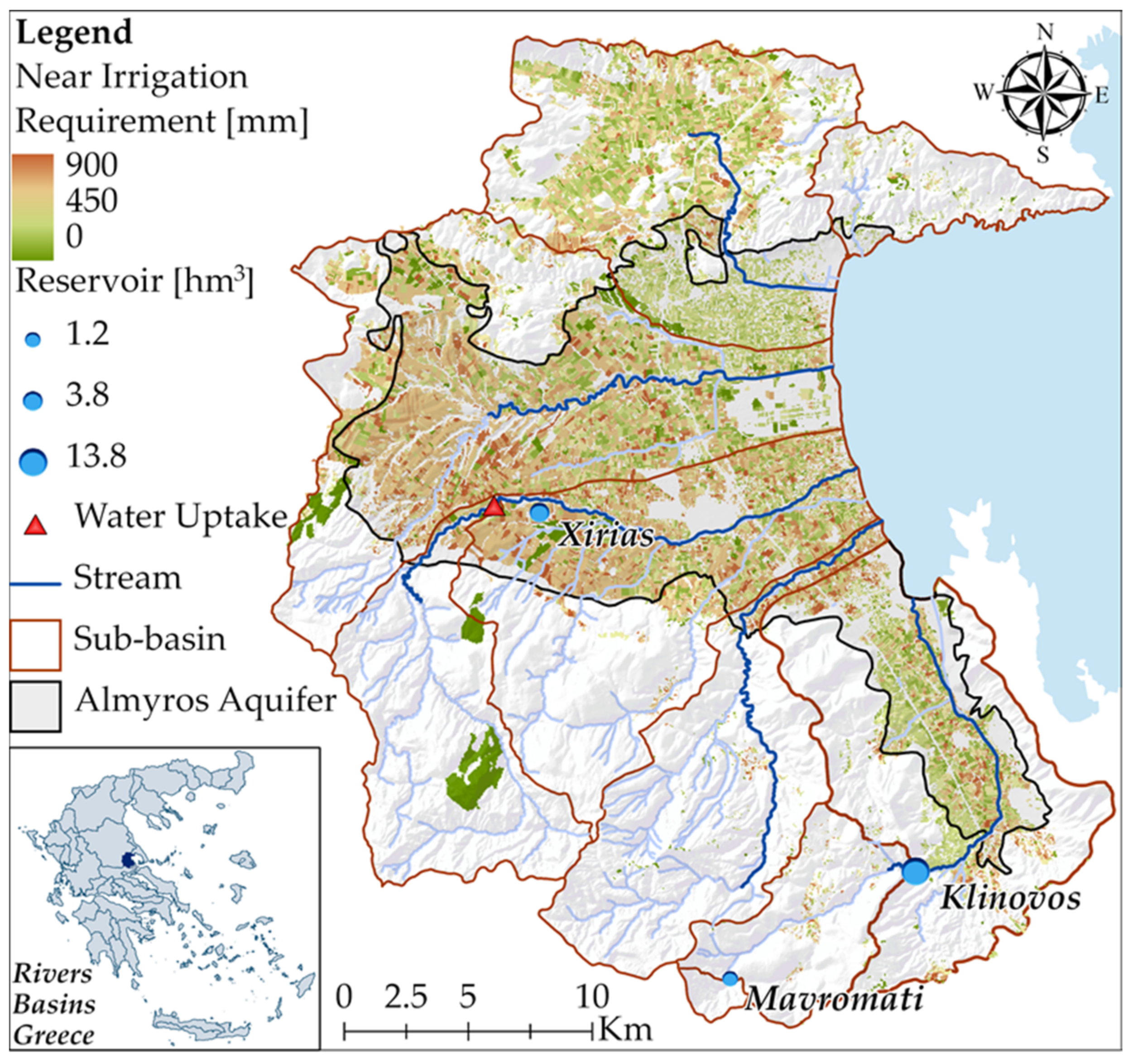


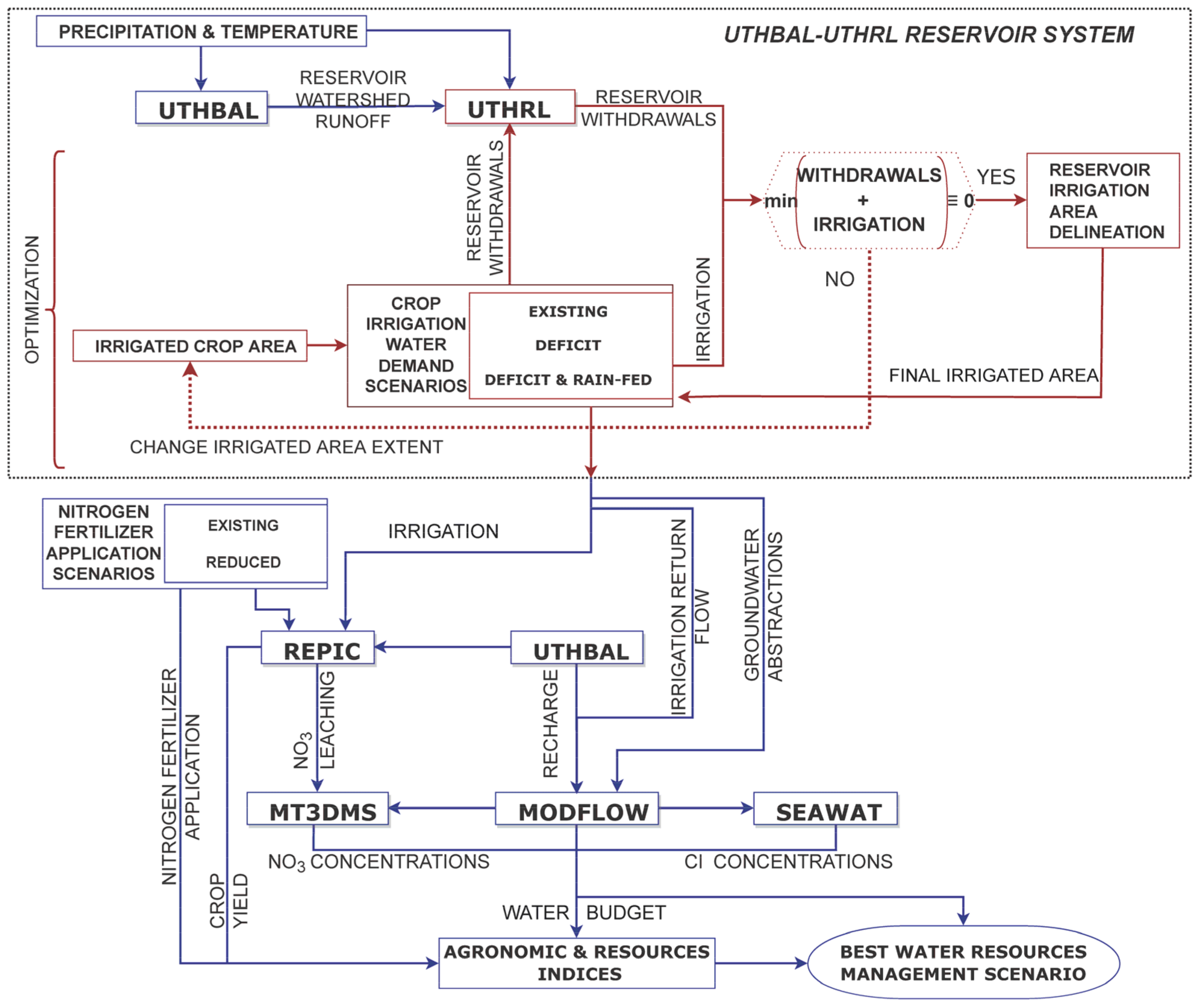
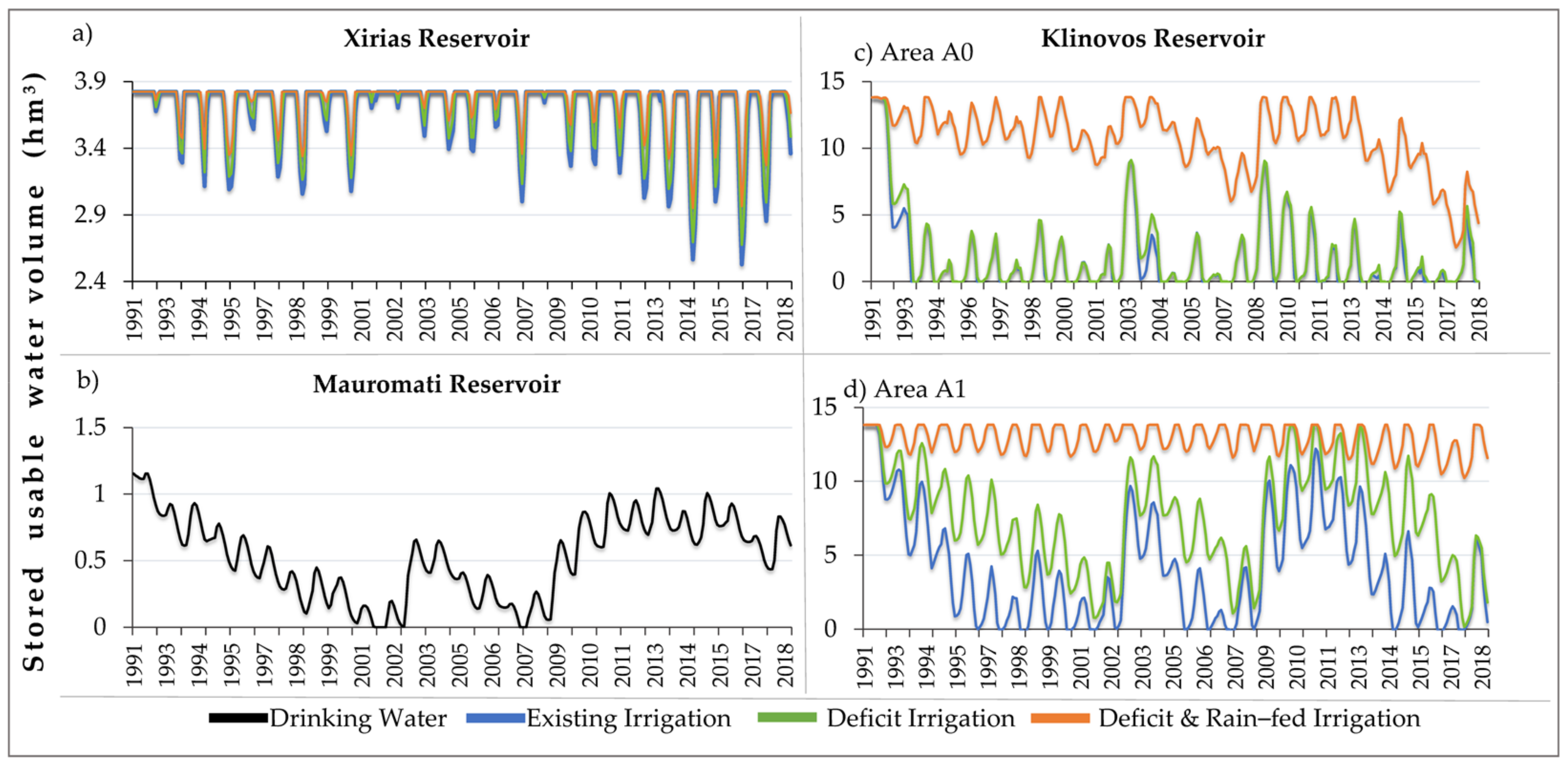
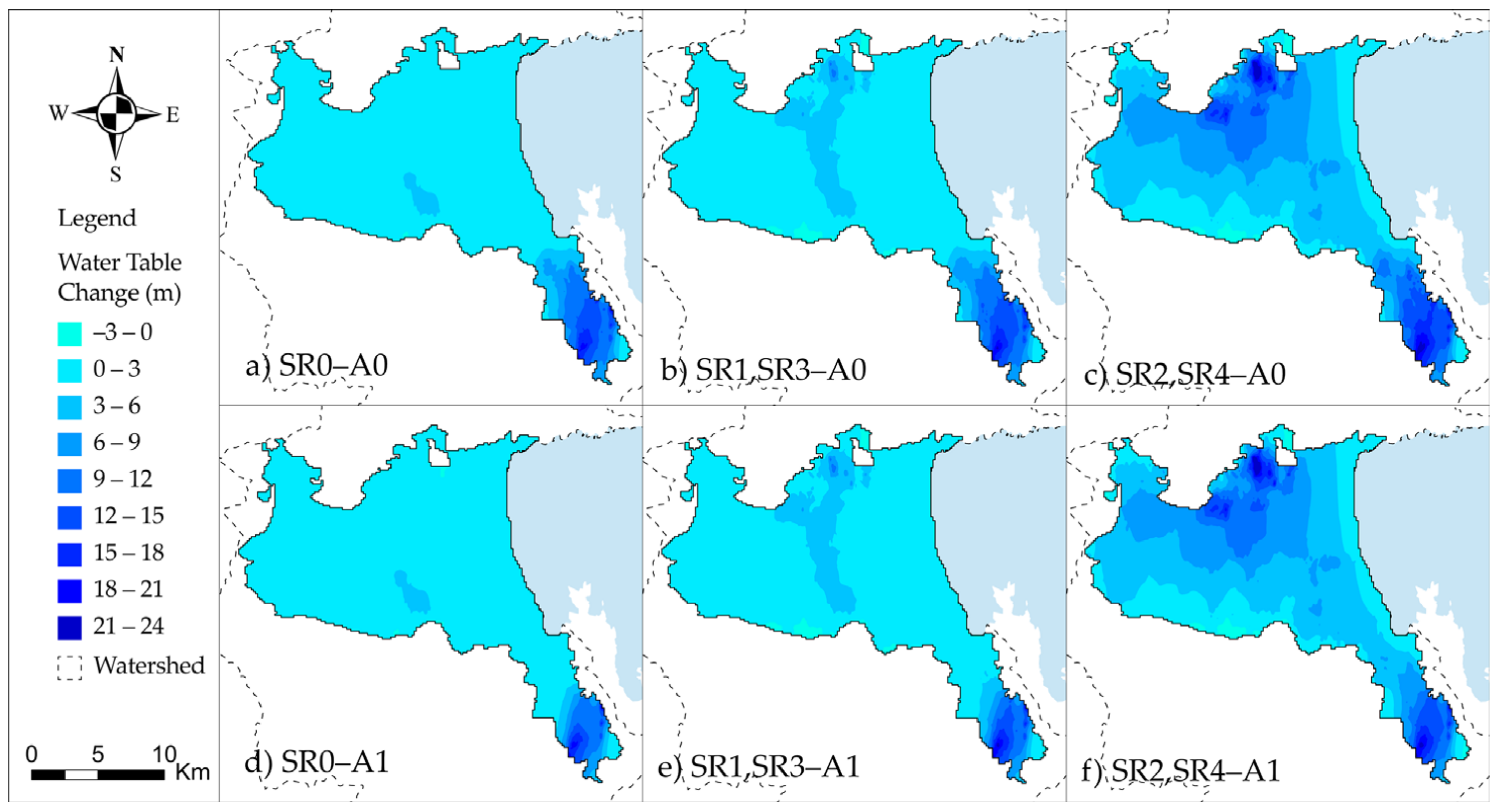


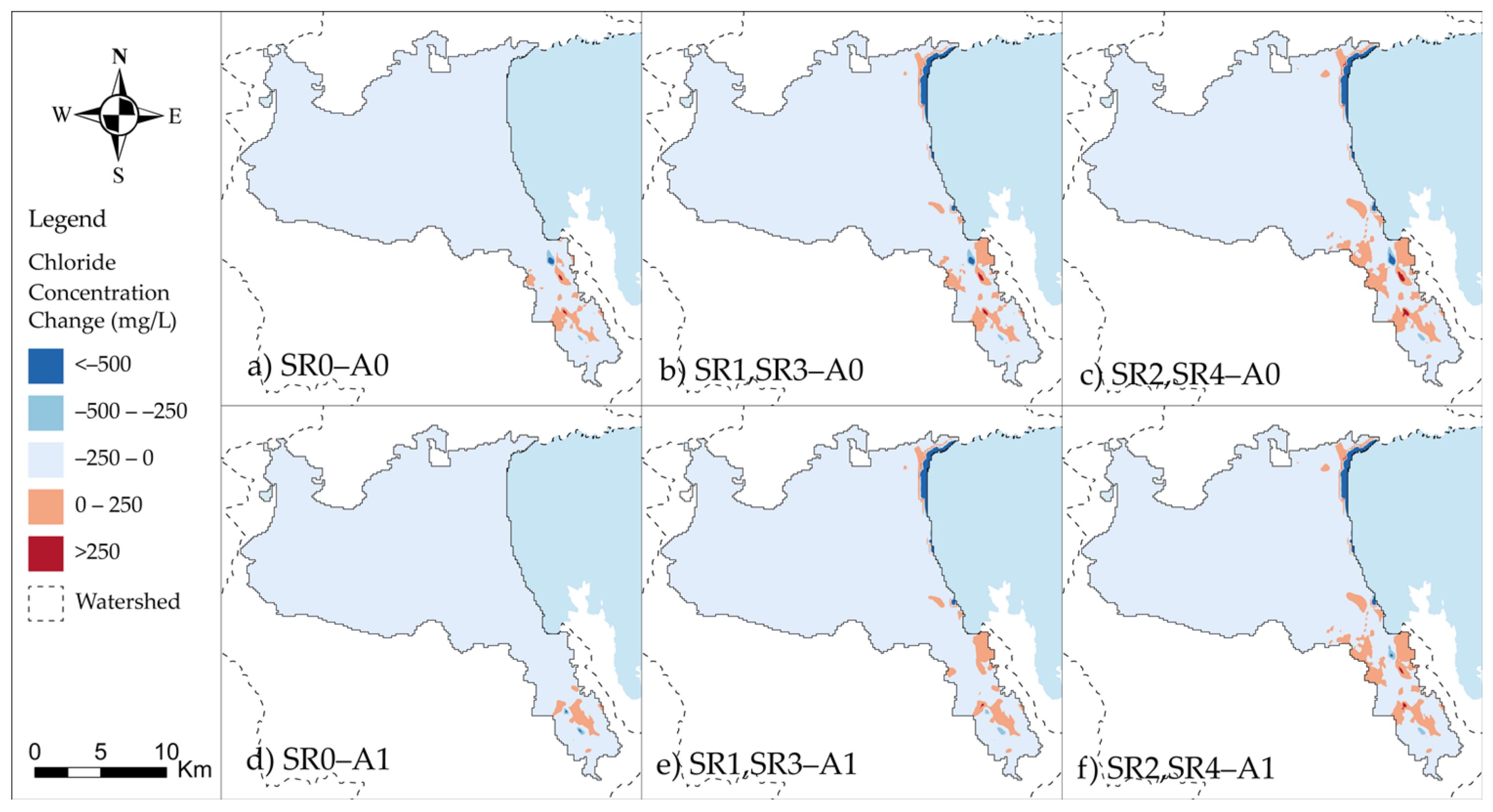



| Sub–Basin | Xirias Upstream | Xirias Downstream | Mavromati Upstream | Mavromati Downstream and Klinovos Upstream | Klinovos Downstream |
|---|---|---|---|---|---|
| Area (km2) | 81.32 | 136.14 | 3.65 | 40.48 | 129.04 |
| Mean Elevation (m) | 930.8 | 297.5 | 1054.5 | 641.9 | 174.4 |
| Curve Number (CN) | 54.93 | 59.95 | 60.08 | 54.8 | 50.65 |
| Location | Elevation (m) | Water Demand 1991 (hm3) | Water Demand 2001 (hm3) | Water Demand 2011 (hm3) |
|---|---|---|---|---|
| 1. Achileio | 14 | 0.06 | 0.05 | 0.06 |
| 2. Agia Triada | 66 | 0.03 | 0.03 | 0.02 |
| 3. Agios Ioannis | 500 | 0.01 | 0.005 | 0.03 |
| 4. Agioi Theodoroi | 180 | 0.03 | 0.03 | 0.03 |
| 5. Drumonas | 120 | 0.02 | 0.03 | 0.02 |
| 6. Gavriani | 270 | 0.02 | 0.02 | 0.02 |
| 7. Pteleos | 108 | 0.16 | 0.11 | 0.12 |
| 8. Sourpi | 29 | 0.15 | 0.16 | 0.13 |
| 9. Vrunaina | 450 | 0.05 | 0.04 | 0.03 |
| Industry and Tourism 1 | – | 0.03 | 0.03 | 0.03 |
| Sum | – | 0.56 | 0.49 | 0.48 |
| Scenario | Source of Water | Klinovos Reservoir Irrigated Area | Irrigation | Fertilization |
|---|---|---|---|---|
| S0 | Groundwater | - | Existing | Existing |
| SR0-A0 | Reservoirs and Groundwater | A0 | Existing | Existing |
| SR0-A1 | Reservoirs and Groundwater | A1 | Existing | Existing |
| SR1-A0 | Reservoirs and Groundwater | A0 | Deficit | Existing |
| SR1-A1 | Reservoirs and Groundwater | A1 | Deficit | Existing |
| SR2-A0 | Reservoirs and Groundwater | A0 | Deficit and Rain–fed cultivation | Existing |
| SR2-A1 | Reservoirs and Groundwater | A1 | Deficit and Rain–fed cultivation | Existing |
| SR3-A0 | Reservoirs and Groundwater | A0 | Deficit | Reduced |
| SR3-A1 | Reservoirs and Groundwater | A1 | Deficit | Reduced |
| SR4-A0 | Reservoirs and Groundwater | A0 | Deficit and Rain–fed cultivation | Reduced |
| SR4-A1 | Reservoirs and Groundwater | A1 | Deficit and Rain–fed cultivation | Reduced |
| Irrigated Cropland in km2 | Alfalfa | Cereals | Cotton | Maize | Olives | Trees | Vegetables | Vineyards | Wheat | Sum |
|---|---|---|---|---|---|---|---|---|---|---|
| Xirias | 0.8 | 1.9 | 0.5 | 0.2 | 0.6 | 0 | 0.3 | 0.1 | 2.2 | 6.5 |
| Klinovos Area A0 | 2.5 | 2 | 5.4 | 0.6 | 6.3 | 0.1 | 0.9 | 0.2 | 5.4 | 23.3 |
| Klinovos Area A1 | 1.1 | 0.8 | 1.6 | 0.2 | 3.9 | 0 | 0.4 | 0.1 | 2 | 10.2 |
| Reservoir Sub-Watershed | Xirias Upstream | Xirias Downstream | Mavromati Upstream | Mavromati Downstream/Klinovos Upstream | Klinovos Downstream |
|---|---|---|---|---|---|
| Temperature °C | 13 | 15.7 | 12.4 | 14 | 16.2 |
| Precipitation (mm) | 697 | 539 | 727 | 670 | 560 |
| PET (mm) | 757 | 865 | 735 | 798 | 889 |
| Runoff (mm) | 159 | 96 | 146 | 144 | 93 |
| Recharge (mm) | 75 | 35 | 78 | 59 | 15 |
| Crop Yield (tn/ha) | Baseline | SR1 | SR2 | SR3 | SR4 |
|---|---|---|---|---|---|
| Alfalfa 1 | 11.4 | 11.3 | 11.3 | 11.3 | 11.3 |
| Cereals | 2.4 | 2.4 | 2.4 | 2.4 | 2.4 |
| Cotton 1 | 3.3 | 3.3 | 3.3 | 3.1 | 3.2 |
| Maize | 9.0 | 9.0 | 9.0 | 9.0 | 9.0 |
| Olives 1 | 2.0 | 2.0 | 1.8 | 2.0 | 1.8 |
| Trees | 1.2 | 1.2 | 1.2 | 1.2 | 1.2 |
| Vegetables 1 | 14.5 | 14.4 | 14.4 | 14.4 | 14.4 |
| Vineyards 1 | 6.4 | 5.4 | 5.4 | 4.8 | 5.2 |
| Wheat | 2.6 | 2.6 | 2.6 | 2.6 | 2.6 |
| Reservoir Reliability α (%) | Mavromati | Xirias | Klinovos Area A0 | Klinovos Area A1 |
|---|---|---|---|---|
| Existing (SR0) | 97.2 | 100 | 68.5 | 89.8 |
| Deficit (SR1, SR3) | 97.2 | 100 | 73.8 | 100 |
| Deficit and Rain-fed (SR2, SR4) | 97.2 | 100 | 99.7 | 100 |
Publisher’s Note: MDPI stays neutral with regard to jurisdictional claims in published maps and institutional affiliations. |
© 2022 by the authors. Licensee MDPI, Basel, Switzerland. This article is an open access article distributed under the terms and conditions of the Creative Commons Attribution (CC BY) license (https://creativecommons.org/licenses/by/4.0/).
Share and Cite
Lyra, A.; Loukas, A.; Sidiropoulos, P.; Voudouris, K.; Mylopoulos, N. Integrated Modeling of Agronomic and Water Resources Management Scenarios in a Degraded Coastal Watershed (Almyros Basin, Magnesia, Greece). Water 2022, 14, 1086. https://doi.org/10.3390/w14071086
Lyra A, Loukas A, Sidiropoulos P, Voudouris K, Mylopoulos N. Integrated Modeling of Agronomic and Water Resources Management Scenarios in a Degraded Coastal Watershed (Almyros Basin, Magnesia, Greece). Water. 2022; 14(7):1086. https://doi.org/10.3390/w14071086
Chicago/Turabian StyleLyra, Aikaterini, Athanasios Loukas, Pantelis Sidiropoulos, Konstantinos Voudouris, and Nikitas Mylopoulos. 2022. "Integrated Modeling of Agronomic and Water Resources Management Scenarios in a Degraded Coastal Watershed (Almyros Basin, Magnesia, Greece)" Water 14, no. 7: 1086. https://doi.org/10.3390/w14071086
APA StyleLyra, A., Loukas, A., Sidiropoulos, P., Voudouris, K., & Mylopoulos, N. (2022). Integrated Modeling of Agronomic and Water Resources Management Scenarios in a Degraded Coastal Watershed (Almyros Basin, Magnesia, Greece). Water, 14(7), 1086. https://doi.org/10.3390/w14071086







_S._Voudouris.png)

